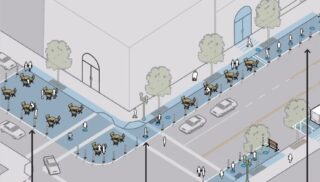“We want to think big about what it means to create plazas to let businesses spill into the streets.”
— Nick Falbo, PBOT senior transportation planner
The City of Portland is on the verge of unleashing one of the most innovative and potentially transformative street-related policies we’ve ever seen. And in a flip-the-script moment only an unprecedented pandemic could create, their main argument for using more street space for people — and less for drivers and their cars — is to help businesses survive.
“PBOT is more than just an infrastructure agent. We are what helps make business work.”
— Art Pearce, PBOT Policy, Planning and Projects Group Manager
We shared news yesterday of the upcoming program from the Portland Bureau of Transportation that will allow local business owners to apply for permits so they can offer food and other services in the public right-of-way. This goes far beyond a simple sidewalk dining permit and is expected to fast-track a host of new possibilities like customer queuing zones in what used to be parking spaces and dining tables and barber chairs in streets and parking lots.
Yesterday one of the PBOT planners spearheading the effort, Nick Falbo, gave a preview of this program and an update on their Safe Streets initiative (they’ve dropped the “Slow Streets” part) to the PBOT Budget Advisory Committee.
Falbo made it clear PBOT is serious about changing streets — not just to adapt to the current moment, but to lay groundwork for whatever comes next. He called Safe Streets, “A framework for our path to a better future.” And Falbo’s boss, PBOT Policy, Planning and Projects Manager Art Pearce, said a host of measures designed to create space for business in the street is directly tied to economics.
“PBOT is more than just an infrastructure agent,” Pearce told the committee. “We are what helps make business work. Getting goods to those businesses and also helping them survive. It’s a critical moment for that intervention and for us to make right-of-way available for that use.”
Those are strong words from an agency often marked (true or not) with an anti-business label.
PBOT’s current mojo is due in part to the successful implementation of 100 sets of signs and barricades on neighborhood greenways. Despite a claim made recently in a Facebook comment from PBOT Commissioner Chloe Eudaly that the barricades have “a lot of opposition,” Falbo took a different view. “We’ve gotten tremendous, positive response to this program,” he said.
Advertisement
While PBOT monitors the barricades and considers making permanent diverters later where necessary, the big news from yesterday’s meeting were the updates on the other two pillars of the Safe Streets initiative: Adding space for people and businesses on main streets.
Falbo revealed that PBOT is focusing the first phase of their implementation of wider sidewalks in east Portland. Locations are being selected based on the city’s data on equity gaps and walking demand. A map and examples (shown below) highlighted neighborhoods from Montavilla to Rosewood, Parkrose to Lents. PBOT will lean on their PedPDX Plan which has already identified “pedestrian districts” in these areas.
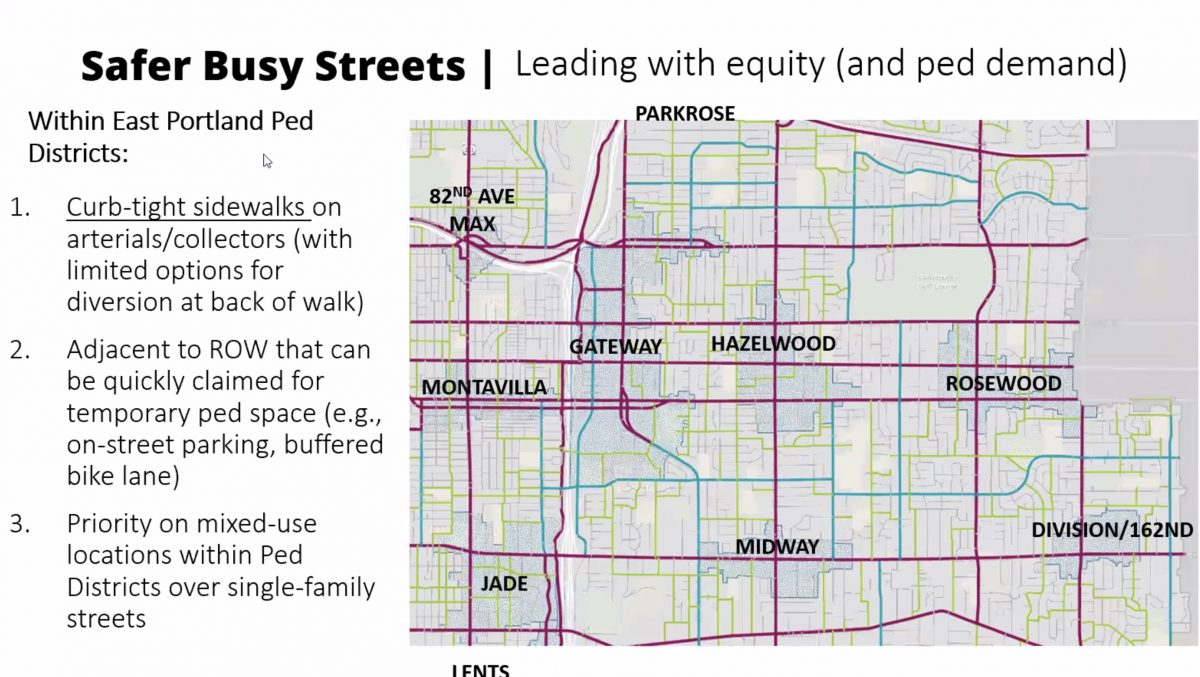
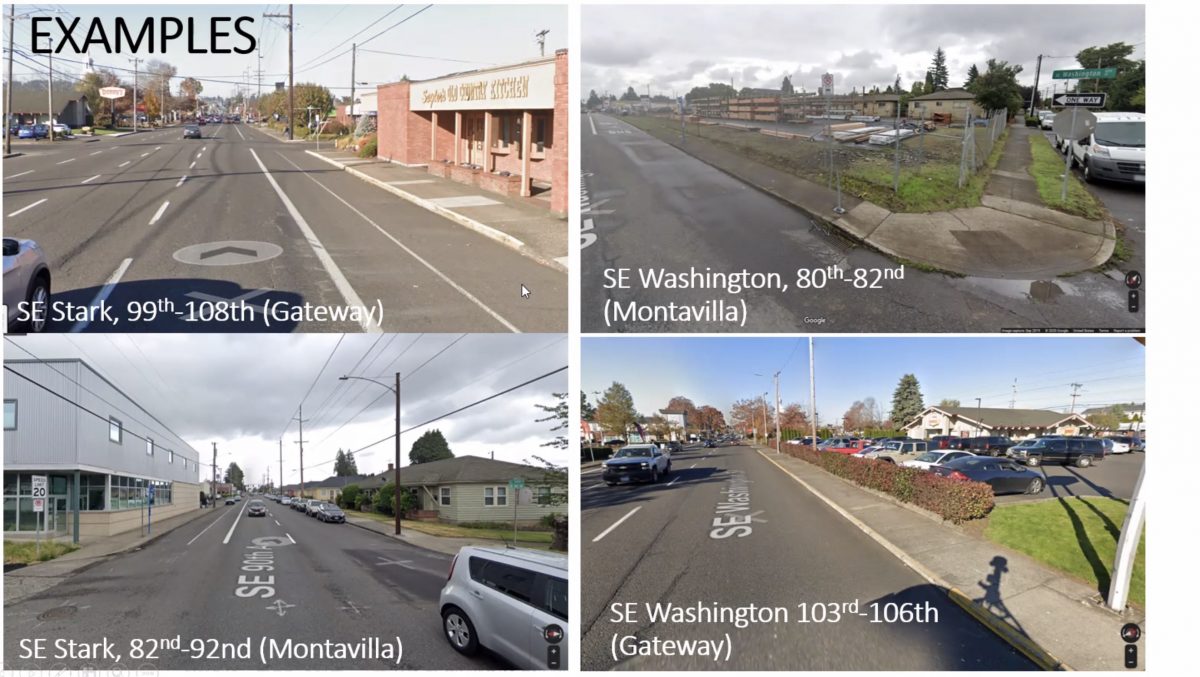
PBOT gave a hint to what these wider sidewalks will look like and said they’re inspired by what they’ve seen in New York City.
When it comes to expanding business space, Falbo said the agency is creating a “toolkit of interventions” they can offer businesses to help them adapt to a re-opening of retail services along with distancing guidelines. “We want to make sure they can use the curb zone to prioritize their needs.”
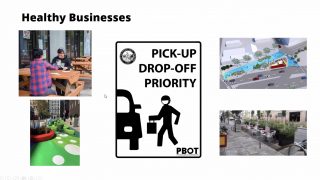
“We’re envisioning a broad array of potential business-serving uses in the right-of-way itself,” Falbo shared. “It might be in the parking lane (like the Street Seats program), but we also want to think big about what it means to take over half or full streets to create the plazas to let businesses spill into the streets and give people the space they need.”
Yes you read that right. More robust driving restrictions could be in the future as PBOT looks to squeeze every ounce of potential from our public street space. Below is a slide of their outdoor dining and other business-centric proposals. (Note: The presence of drivers and their cars in this image is troubling. PBOT might underestimate how incompatible these human-centric street uses are with the presence of loud, smelly, anti-social and scary motorized vehicles are. A similar illustration released yesterday by NACTO showed bikers and walkers, not car drivers.)
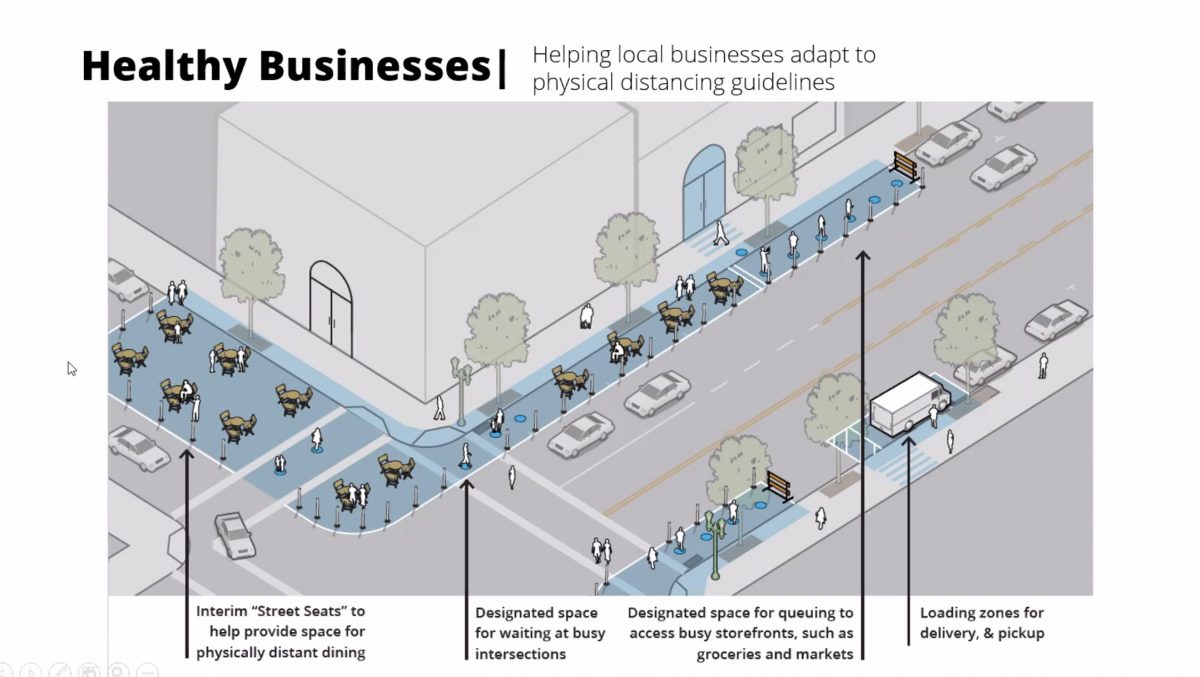
Advertisement
During a Q & A session, Falbo answered a question about the long-term potential of these proposals that I found very compelling. Here’s his full answer, which I think gives us valuable insight into where PBOT’s priorities are:
“If today, the focus is using that curb zone for a place to stand while you wait for your pizza to be made so you can pick it up and take it home, that’s using it for the condition we’re in now. But as we reopen restaurants and come back into the street and restart public life, maybe that space turns into street seats so you can eat that pizza while keeping a distance from the people at the table next to you. Then as we emerge from that and don’t need to keep that same distance anymore, I would hope these businesses can see the appeal of having more space for more customers and maybe those become permanent streetscape installations. And then as part of a future streetscape project we turn that into a curb extension that formalizes that public space.”
“How can you justify this expense when you’re asking other divisions to cut back?”— Douglas Armstrong, Budget Advisory Committee member
Falbo described PBOT’s approach as a “Pipeline to a better future.” “We can’t say that’s where we’re going to be,” he said. “But if we can do everything right and support our communities that might be where we end up.”
It wasn’t all roses and unicorns at the meeting. Advisory committee member Douglas Armstrong who represents the East Portland Land Use and Transportation Committee demanded to know how PBOT could pay for these proposals when so much of the city still lacks basic infrastructure. “I’m right there with you when it comes to public safety and having streets be as safe as possible,” Armstrong said. “But we have core issues that need to be addressed before we start adding bells and whistles on additional programs. How can you justify this expense when you’re asking other divisions to cut back?”
Pearce stepped in to defend the work: “We may be coming from a different place of seeing the urgency of this. I see this as part of the critical work our staff is doing… I don’t see this as an either/or transaction. One of the critical things is economic recovery.” And even PBOT Director Chris Warner chimed in to add even more weight to PBOT’s plans. “This is something we feel we need to do and we have council support to do it.” So far PBOT has spent $100,000 on the barricade installations and additional funding is coming from existing operating revenue. Federal Covid-19 stimulus grants are also likely to be part of the funding equation.
Adding to PBOT’s urgency is their sense that very few Portlanders will go back to taking transit, which means they must make streets work more efficiently — something that’s impossible when they’re clogged with single-occupancy car drivers. “We anticipate transit to be highly compromised over the next period of time because [of physical distancing requirements] we can’t fit a lot of people on buses or the MAX and we’re not sure what type of public sentiment there will be toward riding transit,” Falbo said. “So how do we make sure that a significant portion of Portlanders that use transit to get around don’t just shift to driving a personal car? That would be a bad move when it comes to VMT [vehicle miles traveled], carbon emissions, and safety.”
One way to ensure fewer people drive is to make other options more attractive. If PBOT is able to transfer street space away from the behavior that’s least supported by our adopted plans and goals and toward things like equitable and sustainable mobility and commerce that benefits local businesses, we just might emerge from this in a better place.
— Jonathan Maus: (503) 706-8804, @jonathan_maus on Twitter and jonathan@bikeportland.org
— Get our headlines delivered to your inbox.
— Support this independent community media outlet with a one-time contribution or monthly subscription.

